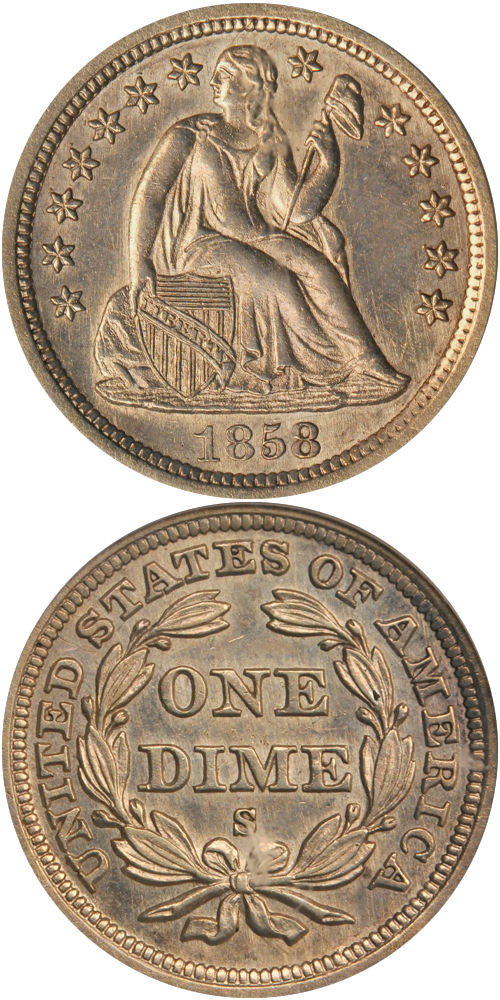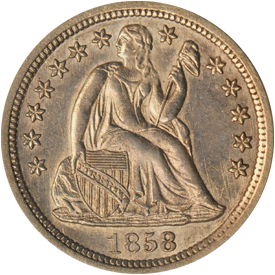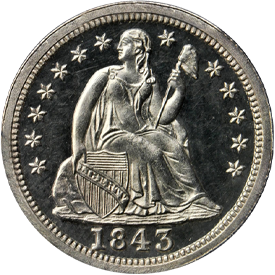Designed by: Christian Gobrecht
Issue Dates: 1838-1853, 1856-1860
Composition: 90% silver, 10% copper
Diameter: 17.9 mm
Weight: 2.67 grams (41.20 grains, 1838 to 1853), 2.49 grams (38.42 grains, 1856 to 1860)
Edge: Reeded
Business Strike Mintage: 42,962,915
Proof Mintage: Fewer than 1,500 pieces
In 1838, stars were added to the obverse of the Liberty Seated motif. This style was continued through 1859, plus 1860 at the San Francisco Mint only. The reverse is similar to the preceding but the wreath on the later issues is slightly heavier. Early issues lack drapery at Miss Liberty's elbow.
The type set collector has his choice of numerous varieties within this span, including a number of New Orleans and San Francisco Mint pieces. While issues such as 1844, 1845-0, 1846, and certain San Francisco pieces are rare, enough common issues exist that no difficulty will be experienced in acquiring a typical example from Good to Extremely Fine grade. AU pieces are slightly harder to find, and Uncirculated coins are scarcer still. Superb Uncirculated pieces are quite elusive. As is the case with half dimes, certain dimes of 1853 and all dimes of 1854 and 1855 have arrows at the date and are considered to be separate types.
Further Reading
In 1838 stars were added to the obverse. This design was continued through 1860 (in 1860 this type was struck only at San Francisco). A further variation is provided by 1853-1855 pieces with arrows at the date, to signify a slight reduction in weight beginning the former year. Although most numismatists do not include them as a separate type in sets, issues of the first several years of the With-Stars obverse are without drapery at the elbow of Miss Liberty.
In worn grades dimes of the 1840s exist in proportion to their mintages. Especially scarce are the Philadelphia Mint issues of 1844 and 1846. In Uncirculated grade dimes of the 1840s are all scarce, and virtually without exception New Orleans Mint issues are extreme rarities. In the history of numismatics no one has ever completed a set of Liberty Seated dimes in Uncirculated condition, to the best of my knowledge. The main stumbling blocks occur during the first decade of production.
One of the most interesting issues among Liberty Seated dimes of the 1840s is the so-called "Orphan Annie" issue of 1844. The first edition of A Guide Book of United States Coins, 1947, had the following to say:
"ORPHAN ANNIE DIME. The record shows that 72,500 dimes were minted in 1844. For some mysterious reason very few of these dimes are still available, and old collectors state that they have been a scarce item back as far as can be remembered. The dimes of 1846, for instance, are much more plentiful though less than half as many were struck.”
Many explanations have been advanced, but none has been proved. Among the most popular theories and legends are the following: melted by the government; melted by speculators, because their bullion value exceeded their monetary value; 50,000 of the dimes were lost at sea enroute to New Orleans; a great quantity were destroyed in the great Chicago fire, or the Johnstown Flood; during the Mexican War our soldiers were paid off in 1844 dimes, and the coins remained in Mexico; 70,000 dimes of 1844 were sent overland to the forty-niners in California, but before reaching the destination by the Santa Fe Trail they were seized by bandits who cached them. The bandits who were later killed carried the secret of the hiding place to their shallow graves.”
This romantic notation was dropped from later Guide Book issues, presumably due to lack of space. Later references to the Orphan Annie Dime are few and far between, but I note that Kamal Ahwash in his Encyclopedia of United States Liberty Seated Dimes 1837-1891 has a footnote: "The late Frank C. Ross, Kansas City, who wrote a coin column for Hobbies magazine for many years, is credited with the nickname.”
San Francisco dimes were first struck in 1856. In Uncirculated grade all early S-mint dimes are rarities. Even in worn condition they are elusive.








